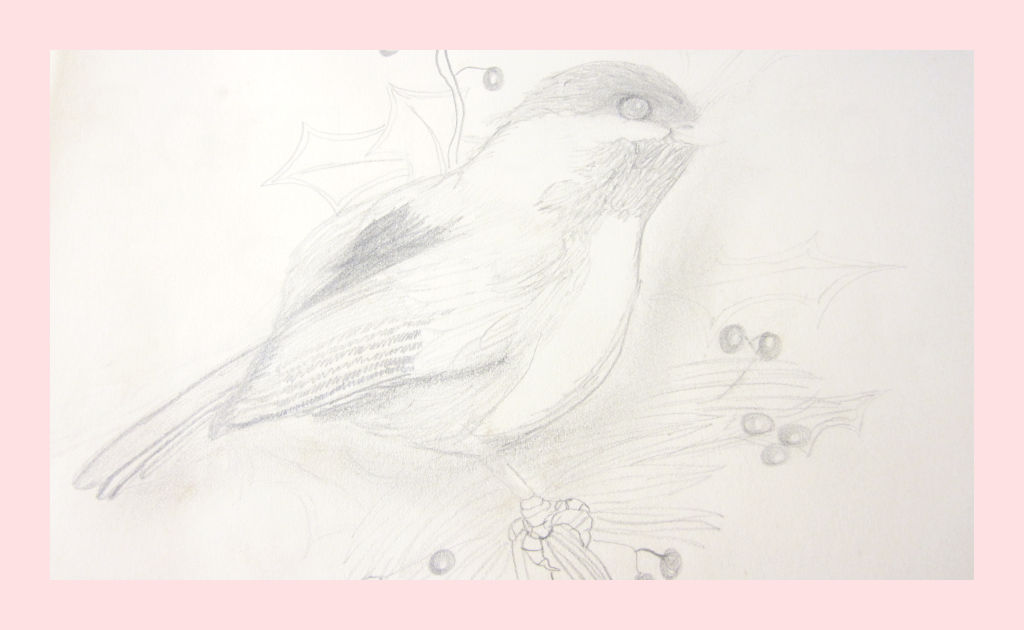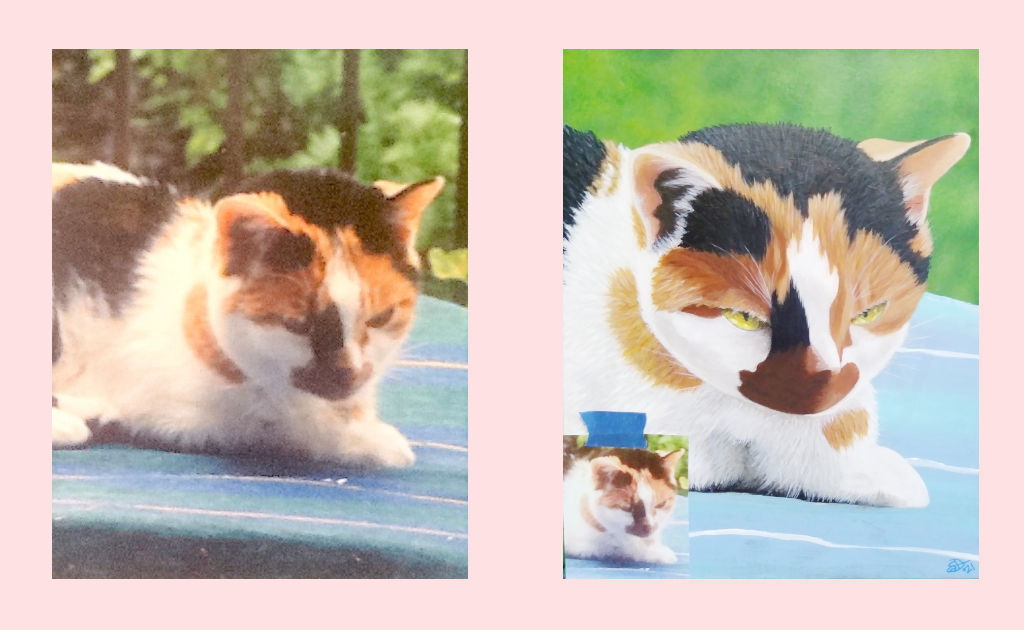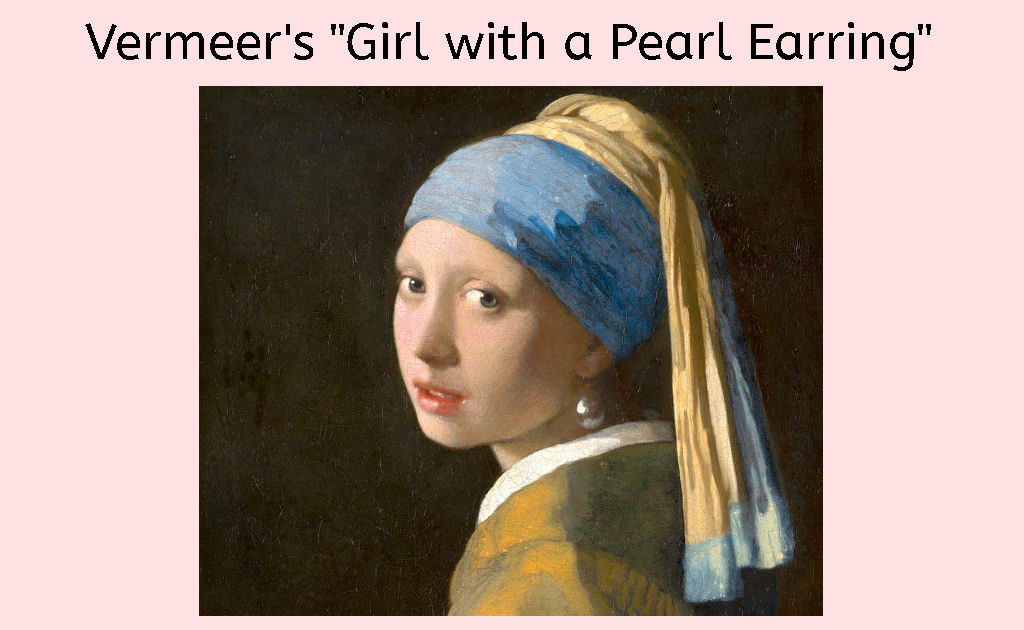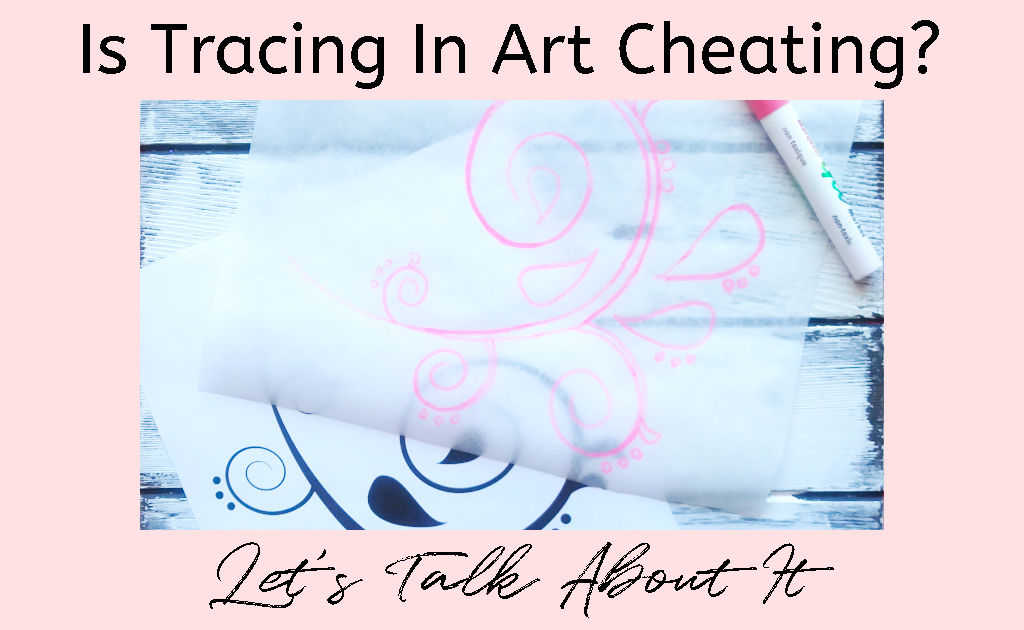In the art world, tracing can be a dirty word and often causes a lot of controversy. But is tracing in art really cheating? Nope, and I’m going to tell you why.
I use tracing to get basic shapes onto canvas a lot. I actually started my art journey with sketching. Still, I prefer to trace when painting to save time and get down to the meat and potatoes of my art as soon as possible.
So, let’s talk about why some artists think it’s cheating, why it’s not, the many benefits, and everything in between. Let’s get right into it.
In This Article...
True Or False: Tracing For Painting Makes You A Fraud
Before we go any further, let’s address the ginormous purple elephant in the art studio.
Is tracing in art cheating? Absolutely not! When you are tracing for the purposes of acrylic painting, you are using it as a tool to get the bare minimum of shapes onto your canvas. Think of tracing as cutting out the middle man to get paint onto canvas quickly. The real magic begins when you start adding details with paint.
The Only Rule In Art
Art, particularly painting, doesn’t have any stringent rules except one: Never copy someone else’s work and pass it off as your own. Just. Don’t. Do. It. This includes tracing someone’s artwork and passing the sketch off as your own. Big no-no!
Other than that, you’re free to build your own artistic journey any way you want and tracing can totally be a part of that process.
There are some myths about what is considered “real art,” which I think is a ridiculous phrase. Who gets the right to call art real or fake? Who decides who is allowed to call themselves an artist? And, who will come to arrest you if you use tracing in art projects? Puh-lease!
Tracing As Part Of Your Art Practice: Setting The Record Straight
To understand why tracing in art is so controversial, we need to talk about the different myths associated with the practice. Keep in mind, Squishing Paint is home to all things acrylic painting, so we’ll only be talking about tracing from that perspective.
Lie #1: You Need To Know How To Draw To Paint
Not even a little bit. As someone who sketches, I can tell you that it is a wonderful skill, but painting can still be accomplished without knowing how to draw.
Think about it, sketching is an art form in itself, just like painting is. Also, what about abstract art? You certainly don’t need to be able to sketch to paint an abstract!
The Short Answer
No, you don’t need to know how to draw to be able to paint. The two are both equally great art forms, but one is not necessary to do the other. Therefore, tracing in art does not diminish the final painting.

I drew this sketch wayyyy back in the day when I was just a young whipper snapper. Even though I can sketch, I choose to trace. To me, painting and sketching are two separate art forms.
Lie #2: Outlining An Image Hinders The Artistic Process
When it comes to tracing for the purposes of acrylic painting, this is a big fat lie because you are only using it to figure out your composition.
As an acrylic artist, I can tell you that the majority of a painting doesn’t even start coming together until you start adding in the details, which isn’t until you can almost see the finish line of an art project.
The Short Answer
Tracing doesn’t hinder the artistic process because, in painting, it’s only used to get basic shapes onto your work surface. A painting becomes something special later in the creative process when you add details.
Lie #3: Tracing Is Cheating Because You Can’t Properly Learn The Importance Of Shape/Proportions/Perspective
Most people have a basic understanding of perspective simply by observing the world around them.
I mean, you realize that things in the distance look smaller/skinnier than things close to you, right?
And, even if they aren’t smaller (i.e., a mountain range), you can see how objects have more detail the closer they are to you and how things far away become more out of focus, less vibrant, etc.
As for shape, again, that’s all in the details. A sketch of a ball is just a circle until you start adding highlights and shadows, and the same is true in painting.
Proportion in art is a shape’s size compared to surrounding forms (so, the eyes in a portrait are the same size, or an apple being larger than a grape but not so big that it looks like a pumpkin).
If you’ve been painting with acrylics long enough, you know that there is an “ugly stage” to each painting. Until you’ve passed this point, everything looks wonky! Learning proportions comes with refining your artwork long after you’ve got things blocked in.
The Short Answer
Perspective, proportion, and shape can still be learned if you trace objects for painting. Form is realized when you start adding shadows and highlights. That is what gives an object dimension, whether you accomplish it using a pencil or a paintbrush. Perspective is achieved through size, color, and detail. And proportions are learned when refining and adding details.
So, is copying the outline of an image cheating when you’re only using it to get a general composition figured out for a painting? No way. Not even close. You should never feel like a fraud for tracing, and if it makes your art process more enjoyable, I say go for it!

As you can see in the photo on the left, I was working with a blurry image with a lot of shadows. Tracing the general shape of the cat helped me so much with mapping out the proportions.
Why Artists Use Tracing In Their Art Process
There are many great reasons why an artist might decide to copy an outline of an image.
- It saves time
- It allows you to play around with the composition before committing it to the canvas
- It can help with accuracy (which is super helpful when you’re painting hyper-realism)
Save Time By Tracing For A Painting Composition
Tracing basic shapes from different images to develop a complete composition saves you so much time that is better spent on the details later on.
Remember, anything you transfer to canvas will be covered in paint, so you don’t want to get too precious about the shading and exact form.
Use An Outline Copy To Experiment Before Committing
Tracing in art can be really helpful because you can play around with the composition before transferring it to your painting surface.
You can move your traced shapes around the canvas to find the perfect placement. You can also use tracing to create a mirror image which takes the guesswork out of painting reflections and even create exact matches to another object in your composition (i.e., eyes, ears, etc.).
Tracing For Accuracy
When artists are painting hyper-realism, it can be a real time saver to make copies of an image. Tracing allows you to be very accurate, and I have used it many times when painting pet portraits.
Sometimes, a detailed painting can get away from you, so it’s nice to have an accurate tracing that you can use to re-transfer over the sections that went off course.
Famous Artists Who May Have Traced *Gasp!*
Pssst! There are rumors that Rembrandt used optical equipment, like lenses, mirrors, and a device called the “camera obscura”.
The camera obscura was basically a box (wayyyyy back in the day, it was actually a whole building) with a tiny hole in one wall that would project things onto the opposite wall. It was the beginning of the cameras we know today and was also used to view solar eclipses.
Another rumor that hints at tracing is that Vermeer, creator of “Girl With a Pearl Earring”, also used the camera obscura.

In addition, it’s well known that Norman Rockwell used a projector to create his works of art. He would take photos and then project them for tracing. Does that make his work any less valid? Not even a little bit!
Science is also getting in on the mystery. Research suggests that different devices like mirrors, camera obscura, and lenses have been used to create compositions for centuries.
Read the article “Science Suggests Art Masterpieces Were Traced” by ABC News to learn more about the research that has been conducted.
And, if someone tries to shame you for tracing as part of your painting process, send them this interesting read by Smithsonian Magazine about Rembrandt and Vermeer using different equipment to trace images onto painting surfaces. Then tell them that it’s kinda like Santa Clause, some believe and some don’t, but you choose to believe in the magic of tracing!
Devices Used For Tracing In Art
So, now that we know that tracing in art is a-okay, here are some of the options you have to create copies of images for painting:
- Lightbox
- Tracing paper
- Image projector
- Thin paper and a window
- Digital Projector
- Da Vinci Eye app for iOS and Android (unfortunately, not free)
Tracing Lightbox For Art
A tracing lightbox is a tabletop box with a translucent flat top that’s light from inside the box. They are either LED or Fluorescent. They come in a wide variety of sizes and weights. The price point is also varied, depending on how basic or fancy you want to get.
Artists use it by placing the image they want to trace onto the lit surface and placing a piece of paper over the image. The light from the box is bright enough to create crisp outlines to copy but diffused enough that you aren’t blinded.
Tracing Paper
Tracing paper is usually what most beginners to acrylic painting start out with. It’s easy to find, cheap, and doesn’t take up more space than a notepad.
Because the paper is so thin, you only need to lay it over the photo you want to trace, secure it with tape so it doesn’t shift while you’re outlining, and get to it.
Image Projector
Every time someone mentions an image projector, it reminds me of the old slide machines for photos or the overhead projector they used in school. Ha! Anyone else?
Image projectors can enlarge physical images/photos and then project them onto a wall or other flat surface.
These projectors come at different price points and can be very basic or loaded with bells and whistles.
A Window And Thin Paper
This is an extremely affordable option if you are on a very tight budget. All you need is a window, tape, and a thin but strong piece of paper.
Parchment paper is excellent for this and is easily found in most grocery stores where you find plastic wrap, aluminum foil, and wax paper.
Parchment paper is strong but thin enough to easily see the image you want to trace.
Using low tack tape to secure the image you want to copy and a more tacky tape for the parchment paper works best.
Since parchment is slick, getting the tape to stick to it can be more challenging. However, this downside is quickly overruled because it comes in large rolls. This means you aren’t limited by size and can trace large and small images.
If you’re having a hard time picturing this setup, take a look at my article filled with tips for beginners in acrylic painting.
Digital Projector
Digital projectors are very much like their counterpart, the image projector. The most significant difference is that a digital projector can take an image from an electronic device, such as a smartphone, and enlarge it while projecting it onto a flat surface.
This means you can skip the step of printing the image before tracing, making the whole process go even faster.
Fun Fact: If you were wondering if this type of projector is the same as the type used for home theaters, you’re absolutely right! So, although digital projectors can come with a hefty price tag, they are more than worth the money since they are multi-purpose.
Da Vinci Eye App For iOS And Android
Lastly, there are apps out there that you can use for tracing, and one of the most popular is the Da Vinci Eye App.
At a small price, this app is available for both iOS and Android devices and is very popular in the art world.
Basically, the Da Vinci Eye app is placed in front of your canvas using a tripod. You will see a semi-transparent copy of your image with your canvas in the background when you look at the screen on your device.
This app also allows you to zoom in to do really detailed work; you can separate an image into different color layers and then copy it onto your canvas. You can even record time-lapse videos of your art process.
Final Word On Tracing Copies Of Photos For Painting
Tracing in art is a controversial subject, but it is a quick method of getting simple shapes onto your canvas and definitely has a place in the art world.
It can be really helpful for anyone who wants to paint but can’t draw, painting in hyper-realism and creating reflections.
Is tracing cheating? No way! It’s just a means to an end that even some famous artists used as part of their art practice.
Remember, drawing and painting are two equally amazing and individual art skills, but there’s no reason to think you can’t paint if you don’t know how to sketch. Now, make like Norman Rockwell and get to tracing, friend!
What kind of tools have you used to trace? Let me know in the comments.
You May Also Like These Articles Related To Tracing Images:
- Paint a Bright Tulip with Traceable
- Find a Ton of Free Photos You Can Trace
- More Art Rumors that are Worthy of an Eye Roll

Meet Sara, a seasoned veteran in the world of art. With a knack for mixing paints to unveil breathtaking new hues, she’s adorned countless commissions and independently captivated art enthusiasts with her creations. Having spent over a decade immersed in the realm of art gallery management, Sara’s insight into the intricacies of the art scene shines through her work.
But don’t let her impressive résumé fool you – Sara’s approach to art is as lively as her palette. Known for her wit and humor, she infuses her passion for painting with a playful spirit, making every stroke a delightful adventure. As a dedicated mentor, she’s committed to guiding her fellow artists towards success, always staying ahead of the curve with the latest techniques and trends.

